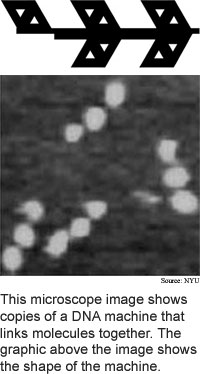
DNA machine links molecules
By
Kimberly Patch,
Technology Research NewsAs nanotechnology progresses, many teams of scientists are working on using DNA's self-assembly abilities to produce molecular-scale machines. Researchers have made several types of mechanical devices out of DNA but until now none has performed useful work.
Researchers from New York University have fashioned a nanomechanical device from DNA that can be programmed to align a series of molecules and fuse them together.
The technique could potentially be used to put together designer polymers, encrypt information, and carry out computations.
DNA is made up of four types of bases -- adenine, cytosine, guanine and thymine -- attached to a sugar-phosphate backbone. Biological DNA acts as a blueprint for the many proteins used by the body.
DNA bases are complementary, meaning adenine connects with thymine and cytosine with guanine. This allows a pair of strands whose bases line up -- adenine across from thymine, and cytosine across from guanine -- to pair into a double strand. To replicate, the pairs separate and each assemble a new set of complementary bases.
Unlike biological DNA replication, the researchers' technique does not depend on complementary sequences, said Nadrian Seeman, a professor of chemistry at New York University.
The researchers' method of DNA assembly acts more like the ribosome, the portion of a cell that works with RNA to assemble amino acids into the proteins that carry out life's processes. The RNA molecule is similar to DNA, and travels outside the cellular nucleus.
The researchers' DNA machine consists of a pair of connected nanomechanical devices that each rotate a pair of wings through half-turns around an axis. The device has four mechanical positions, or states, that are determined by particular instruction, or set, strands of DNA.
The machine has a fifth, fixed wing so that in all four states there is a row of three wings across the top of the device. The machine is assembled and operated in a solution that contains the component molecules of the polymer strands the machine is to build. The component molecules, which were DNA sequences in the researchers' initial experiments, are attached lengthwise to DNA strands whose ends attach to the corners of the machine's wings.
There are six component molecules. Two of the component molecules' attendant DNA strands fit in the gap between the first and second wings. Four of the molecules' attendant DNA strands fit in the gap between the second and third wings, depending on the wing configuration.
The first component molecule can be lined up with the third or fourth component molecules and the second with the fifth or sixth, yielding four possible end products consisting of a pair of fused molecules. The initial experiments yielded specific DNA sequences that were 307 DNA bases long.
The researchers have also been able to add nylon to nucleic acids, said Seeman. The molecule assembly technique could eventually be used to construct polymers molecule-by-molecule, he said. "We expect to be able to use the system, or its next version, to include a series of polymers that can be assembled in a particular order."
The technique can be used to encrypt information simply by providing a code that relates a particular sequence to the information it represents.
The technique could be used as an input device for a DNA computer, which could carry out massively parallel computations or control a drug delivery system in the body. The first strand can be used as the base for another layer, which, in turn, can be used as the base for another layer, and so on to self-assemble the computer's output, said Seeman.
The researchers' next step is to make a translocational, rather than rotary device, said Seeman. The current device can only assemble molecular strands that are about as long as the device itself. A translocational device would, like ribosomes, be able to assemble longer strands.
The technique could be used practically within five years, said Seaman.
Seeman's research colleague was Shiping Liao. The work appeared in the December 17, 2004 issue of Science. The research was funded by the National Science Foundation (NSF), the National Institutes of Health (NIH), the Office of Naval Research (ONR) and Nanoscience Technologies, Inc.
Timeline: 5 years
Funding: and the Corporate; Government
TRN Categories: DNA; Nanotechnology
Story Type: News
Related Elements: Technical paper, "Translation of DNA Signals into Polymer Assembly Instructions," Science, December 17, 2004
Advertisements:
June 15/22, 2005
Page One
Stories:
Robot runs like humans
DNA machine links molecules
Process ups biodiesel efficiency
How It Works: Power sources
Briefs:
Nanowire computer circuits debut
Lens boosts LED efficiency
Quantum crypto boosted to 2 GHz
Single camera measures speed

News:
Research News Roundup
Research Watch blog
Features:
View from the High Ground Q&A
How It Works
RSS Feeds:
News
Ad links:
Buy an ad link
| Advertisements:
|
 |
Ad links: Clear History
Buy an ad link
|
TRN
Newswire and Headline Feeds for Web sites
|
© Copyright Technology Research News, LLC 2000-2006. All rights reserved.